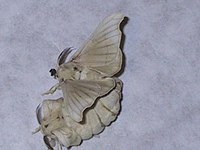
Photo from wikipedia
The quality of Beauveria bassiana conidia directly affects the virulence against insects. In this study, continuous subculturing of B. bassiana on both rice grains and potato dextrose agar (PDA) resulted… Click to show full abstract
The quality of Beauveria bassiana conidia directly affects the virulence against insects. In this study, continuous subculturing of B. bassiana on both rice grains and potato dextrose agar (PDA) resulted in 55 and 49 % conidial yield reduction after 12 passages and 68 and 60 % virulence reduction after 20 and 12 passages at four d post-inoculation, respectively. The passage through Tenebrio molitor and Spodoptera exigua restored the virulence of rice and PDA subcultures, respectively. To explore the molecular mechanisms underlying the conidial quality and the decline of virulence after multiple subculturing, we investigated the conidial proteomic changes. Successive subculturing markedly increased the protein levels in oxidative stress response, autophagy, amino acid homeostasis, and apoptosis, but decreased the protein levels in DNA repair, ribosome biogenesis, energy metabolism, and virulence. The nitro blue tetrazolium assay verified that the late subculture's colony and conidia had a higher oxidative stress level than the early subculture. A 2A-type protein phosphatase and a Pleckstrin homology domain protein Slm1, effector proteins of the target of rapamycin (TOR) complex 1 and 2, respectively, were dramatically increased in the late subculture. These results suggest that TOR signalling might be associated with ageing in B. bassiana late subculture, in turn affecting its physiological characteristics and virulence.
Journal Title: Fungal biology
Year Published: 2018
Link to full text (if available)
Share on Social Media: Sign Up to like & get
recommendations!